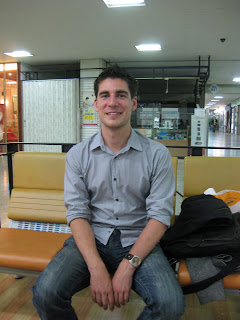South Korea's Public TransportationHave you heard about B. M. W group in South Korea? I am not talking about a group of people who purchase luxury motor. Nowadays, B. M. W group is known as people who always use public transportation (it stands for Bus, Metro, and Walk) in Korean Society. As you see, most of Korean cities with more than about 50,000 people are linked by well developed public transportations such as bus, transit, air, taxi, and even ferry. However, it is not easy to adventure at first. So I am giving some basic tips about Korean Public Transportation. Be a one of proud B. M. W members!
 Subway/Metro
Subway/MetroThe Seoul-Incheon subway system is one of the largest in the world, with over 300 stations. The Greater Seoul subway network extends well beyond the Seoul city limits, stretching about 80km from North to South, and about 40km from East to West. Station names, instructions, and subway maps are well-posted in Korean and in English. Even when a subway stops at every station, it makes an announcement in English, Chines, and Japanese for foreigners.
Below are links to the official sites for each of Korea's subway systems.
http://www.irtc.co.kr/eng/index.asphttp://www.seoulmetro.co.kr/ Local Bus
Local BusIn 2004, Seoul opened a new chapter in the public transportation, aiming to achieve a transit system that is both faster and more convenient. To reduce confusion and simplify passenger use, each bus in the municipal transit system will now employ one of four colors: blue, green, red or yellow, depending on its function. Now, passengers can easily identify the starting point and the destination of a bus at a single glance.
http://english.seoul.go.kr/images/SeoulBusMap.pdfBlue buses (Main Line) serve the major trunk roads between downtown Seoul and satellite cities of Seoul. The buses have the letter "B" on them, representing blue buses. Bus numbers have 3 digits.
Green buses (Branch Line) serve routes between subway stations and nearby residential areas/main bus lines. (These routes are often covered by village buses) The buses have the letter "G" on them, representing green buses. Bus numbers have 4 digits, starting with "9."
Red buses (Wide Area Line) serve routes between major areas (downtown, Gangnam, Yeongdeungpo, etc.) and metropolitan satellite cities (Ilsan, Bundang, Uijeongbu, etc.). The buses have the letter "R" on them, representing red buses. Bus numbers have 4 digits.
Yellow buses (Circular Line) serve circular belt roads in the downtown and major metropolitan area. The buses have the letter "Y" on them, representing yellow buses. Bus numbers have 2 digits.
 Express Bus
Express BusExpress busses run almost everywhere in Korea. Fares are low (cheaper than the regular train) and service is very frequent. There are special lanes for busses on all major highways, so traffic is not a problem except when entering and leaving major cities.
 Taxi
Taxi Korean Taxis are cheap and abundant comparing to other countries. In most major cities, there are two types of taxis — regular and deluxe. Regular taxis are silver or grey and, if you are alone, you are expected to share the ride with anyone else going in the same direction. It can be difficult to hail a regular tax though; many of the drivers speak very little English and are hesitant to pick up foreigners who look like they haven't taken a taxi in Korea before.
A regular taxi is unlikely to stop for a foreigner who is waving his hands or arms above his head. The minimum fare in regular taxis is W 2,400 in Seoul. You can get as far as 2km with the base fare, making regular taxis very affordable. There is a 20% surcharge after midnight.
Deluxe Taxis, on the other hand, are considerably more expensive, starting at W 5,000 and rising quickly. These taxis are black and have more comfortable interiors. The ride is never shared with strangers and most drivers speak English fairly well.
 Air Travel
Air TravelFifteen Korean cities have air links with each other and/or with Seoul, Busan, and Jeju. Korea has two major Airlines,
Korean Air and
Asiana. Both airlines offer international and domestic service. The low fares and frequent service make it convenient to fly to another region of the country for the weekend, or even just for the day. South Korea has three major international airports: Seoul Incheon (ICN), Busan Gimhae (BUS), and Jeju International (CJU). Note that most international flights from Seoul leave from Incheon Airport and most domestic flights leave from Gimpo Airport, which is about 25km East of Incheon, and is conveniently located on the Seoul subway system.
Korean Airports Corporation Train
TrainA high-speed rail line (KTX) linking Seoul, Daejon, Daegu, and Busan opened in April, 2004. The French-built trains travel at up to 300 km/h and have cut travel time from Seoul to Busan by more than half — to a little over two hours. Fares are reasonable, especially compared with Japan or France — Seoul to Busan one way costs around 45,000 won (US$48). Several other train lines with express and local trains, operate elsewhere, making almost every Korean city reachable by train. You can get more information and book online at
Korean National Railway.Reference
http://www.lifeinkorea.com/information/trans/seoul-trans.cfmhttp://www.hoteltravel.com/south_korea/guides/transport.htm


















